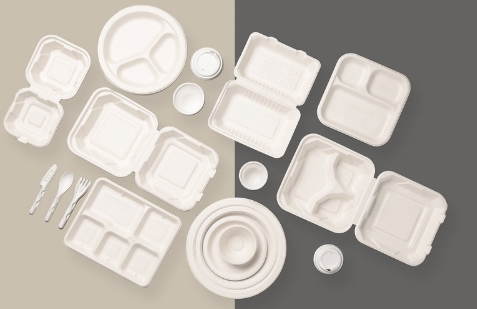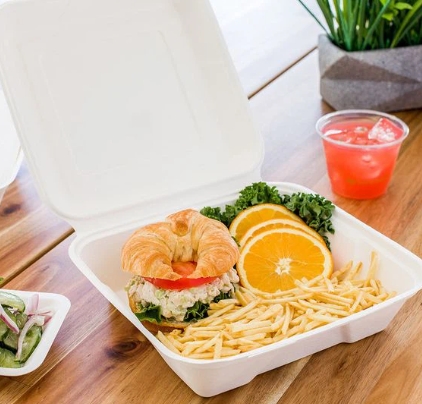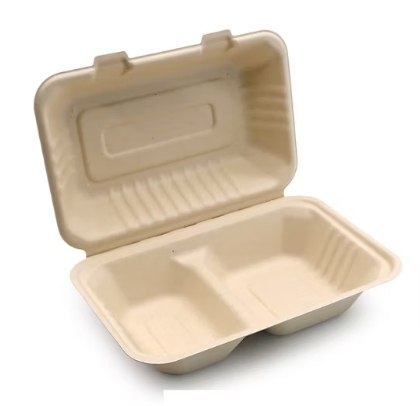
Content Menu
● What Are Clamshell Boxes?
● Types of Clamshell Packaging
>> Plastic Clamshell Boxes
>> Biodegradable Clamshell Boxes
● Environmental Impact
>> Plastic Packaging and Its Footprint
>> How Biodegradable Boxes Compare Environmentally
● Manufacturing and Resource Use
>> Plastic Production Process
>> The Production of Biodegradable Alternatives
● Durability and Performance
>> Strength and Versatility
>> Functionality in Everyday Use
● Disposal and End-of-Life Analysis
>> Plastic Disposal Realities
>> What Happens to Biodegradable Boxes?
● Business Use Case: Transitioning to Biodegradable
● Challenges and Limitations
>> Biodegradable Packaging Barriers
>> Where Plastic Still Dominates
● Innovation in Materials and Design
● Shaping the Future of Packaging
● Conclusion
● Frequently Asked Questions (FAQ)
>> 1. What materials are used to make biodegradable clamshell boxes?
>> 2. Are biodegradable clamshell boxes safe for food?
>> 3. Can I compost biodegradable clamshell boxes at home?
>> 4. Do biodegradable containers cost more than plastic ones?
>> 5. How can a business transition from plastic to biodegradable options?
As environmental consciousness becomes a global priority, the conversation around sustainable packaging alternatives is intensifying. Among the most urgent choices confronting both businesses and consumers is the selection between plastic clamshell boxes and their biodegradable counterparts. These packaging options, often used in food service, retail, and delivery, may seem similar in terms of shape and function. However, they carry vastly different implications for our planet.
This in-depth exploration compares biodegradable and plastic clamshell boxes across multiple dimensions, including production methods, environmental impact, durability, cost, and real-world practicality. The ultimate objective is to provide thoughtful insights that help readers make clear, conscientious decisions about packaging in the age of sustainability.

What Are Clamshell Boxes?
Clamshell boxes are containers with a hinge connecting the top and bottom halves, forming a "clamshell" structure. They're frequently used for packaging food items, electronics, baked goods, and more. Designed for single-use convenience, their material composition plays a crucial role in how they affect the environment after disposal.
Types of Clamshell Packaging
Plastic Clamshell Boxes
Plastic clamshell boxes are made using petroleum derivatives such as polyethylene terephthalate (PET), polypropylene (PP), or polystyrene (PS). They're known for being transparent, lightweight, durable, and economical to mass-produce.
Biodegradable Clamshell Boxes
Biodegradable versions are typically made from natural, renewable materials like sugarcane bagasse, cornstarch, bamboo fibers, and biodegradable plastics such as PLA (polylactic acid). These materials are designed to decompose much faster than traditional plastics, especially under the right composting conditions.
Environmental Impact
Plastic Packaging and Its Footprint
Plastic may be convenient and cost-effective, but its environmental liabilities are severe. Plastics often accumulate in landfills or the natural environment, where they can persist for hundreds of years without breaking down. Over time, these materials fragment into microplastics that infiltrate soil, water, and food chains, posing serious ecological and health concerns.
Even though some types of plastic clamshells are technically recyclable, in practice they are often contaminated with food waste or mixed with incompatible materials, making recycling inefficient or unviable.
How Biodegradable Boxes Compare Environmentally
Biodegradable clamshell boxes are designed to break down through natural processes, returning to the earth without leaving toxic residues. If disposed of correctly—particularly in industrial composting settings—they can decompose within months rather than centuries. Unlike plastics, they generally do not generate harmful microplastics as they degrade.
However, their environmental value depends heavily on proper disposal. When biodegradable boxes end up in landfills, where oxygen and microbial activity are limited, decomposition may slow down considerably.
Manufacturing and Resource Use
Plastic Production Process
Producing plastic clamshells requires extracting petroleum, refining it through energy-intensive processes, and forming it into plastic resins. These manufacturing steps generate greenhouse gases, consume vast amounts of energy, and rely on finite natural resources.
Packaging is then often transported over long distances, adding to its overall carbon footprint through emissions during shipping and logistics.
The Production of Biodegradable Alternatives
Biodegradable packaging starts with renewable agricultural byproducts like sugarcane residue or cornstarch. These waste materials are processed into pulp or resin and molded into clamshell shapes. The production process, in comparison to plastic, typically consumes less energy and water and generates fewer emissions.
Moreover, because many biodegradable materials are sourced from agricultural waste, their production supports circular economies and reduces dependency on virgin materials.
Durability and Performance
Strength and Versatility
Plastic clamshells dominate in terms of resilience and water resistance. They can securely carry both wet and dry goods and are highly valued in settings where presentation and clarity are important, such as fresh produce or takeout meals.
Biodegradable clamshells have improved significantly in recent years. Modern fiber-based containers offer much better strength and grease resistance than early versions. Still, they may struggle when used with very greasy or extremely wet foods. To address this, some companies apply compostable coatings to improve water resistance without compromising compostability.
Functionality in Everyday Use
From a consumer perspective, both types perform similarly in terms of design and ease of use. However, biodegradable containers are increasingly seen as a symbol of brand responsibility. Many customers now associate biodegradable packaging with eco-friendly values, which can influence purchasing decisions and foster customer loyalty.

Disposal and End-of-Life Analysis
Plastic Disposal Realities
Most plastic packaging ends its life in landfills or as litter. Even when recycling is possible, many municipal systems struggle to handle clamshell packaging due to contamination or material-specific issues. This results in high volumes of plastics being incinerated or discarded improperly.
Over decades, plastic packaging slowly breaks into smaller fragments but never truly disappears from the environment.
What Happens to Biodegradable Boxes?
When disposed of through industrial composting systems, biodegradable clamshell boxes can break down into organic matter that enriches soil health. These facilities provide the ideal conditions of heat, moisture, and microbial activity to support rapid decomposition.
Unfortunately, not all regions have access to this infrastructure. When biodegradable clamshells are thrown into standard trash bins and sent to landfills, their decomposition slows markedly, minimizing their environmental advantage.
Business Use Case: Transitioning to Biodegradable
Consider a food service business aiming to reduce its ecological footprint. Switching from plastic to biodegradable clamshell packaging is a visible commitment to sustainability. While cost per unit may be higher, many companies view this as an essential investment in long-term brand equity and regulatory compliance.
Businesses making this switch often attract eco-conscious consumers and gain media attention for their green initiatives. Internally, they may also reduce waste management fees associated with non-compostable waste.
Challenges and Limitations
Biodegradable Packaging Barriers
Despite their advantages, biodegradable options face limitations. Costs remain higher due to limited production scale. Inconsistencies in composting standards across regions also hinder convenience in end-of-life disposal. Additionally, customers may be unaware of proper composting practices, leading to incorrect disposal in traditional trash systems.
Where Plastic Still Dominates
In applications requiring transparency, long shelf life, or high moisture containment, plastic remains the superior material. Until biodegradable technology reaches parity on all fronts, certain sectors may continue to rely on petroleum-based packaging for specific functionality. However, innovation in sustainable materials continues to narrow the gap.
Innovation in Materials and Design
Rapid advancements are underway in both biodegradable and synthetic packaging technologies.
Biodegradable packaging is being enhanced with advanced barriers, coatings, and hybrid materials to improve moisture resistance. These improvements enable better performance in various conditions without compromising compostability.
Meanwhile, developments in chemical recycling and bio-based plastics may allow conventional plastics to be reused in closed-loop systems or produced from non-petroleum sources. While these options are still emerging, they represent significant potential for reducing long-term environmental harm.
Shaping the Future of Packaging
The packaging industry must evolve in tandem with consumer demand, environmental concerns, and technological capabilities. Governments are already implementing bans, taxes, or incentives targeting single-use plastics. Businesses embracing sustainable alternatives now will likely lead in shaping the circular economy of the future.
Adoption of biodegradable clamshells is a step in the right direction. But systemic change requires collaboration across supply chains, waste management infrastructure, education programs, and policy initiatives. Only then can sustainable packaging become the norm rather than the exception.
Conclusion
The decision between biodegradable clamshell boxes and plastic packaging extends far beyond appearance or short-term cost. It's a decision rooted in environmental responsibility, social values, and long-term thinking.
Plastic clamshells, while efficient and cheap, continue to burden the environment with durable waste. Biodegradable alternatives offer a more hopeful path—one that involves regenerating soil, reducing pollution, and promoting circular economies. However, the choice only becomes truly sustainable when supported by proper infrastructure, informed consumers, and responsible business practices.
In the battle of sustainability, biodegradable clamshell boxes hold immense promise. As technology advances and global awareness grows, they may very well become the new standard in sustainable packaging.

Frequently Asked Questions (FAQ)
1. What materials are used to make biodegradable clamshell boxes?
Biodegradable clamshells are commonly made from renewable sources such as bagasse (sugarcane fiber), cornstarch, bamboo, or PLA (a plant-based plastic). These materials can break down under composting conditions, making them an eco-friendly alternative to plastic.
2. Are biodegradable clamshell boxes safe for food?
Yes, most biodegradable clamshell boxes are food-grade and certified as safe for containing both hot and cold foods. They are commonly used for takeout containers, bakery packaging, and grocery applications.
3. Can I compost biodegradable clamshell boxes at home?
Some biodegradable clamshell boxes are home compostable, but many require industrial composting facilities due to their thickness and materials used. Always check the packaging label to determine the correct disposal method.
4. Do biodegradable containers cost more than plastic ones?
Generally, yes. Biodegradable packaging tends to have a higher price point due to the cost of raw materials and limited large-scale manufacturing. However, prices are gradually decreasing as production technologies and demand improve.
5. How can a business transition from plastic to biodegradable options?
Businesses can start by identifying packaging needs that align with available biodegradable alternatives. Partnering with manufacturers or suppliers who offer certified compostable products and educating customers on proper disposal methods will ease the transition and improve environmental outcomes.

















